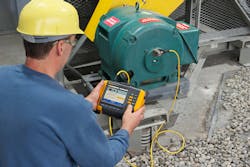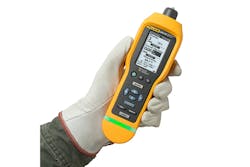Most equipment failures occur randomly, but in-house, routine maintenance can alleviate some of the related yet predictable cost factors. When operators run machinery until failure, which tends to be common practice in many facilities, the company can see reductions in production, expensive repairs, extensive overtime and increased purchases to replace worn-out components.
Several studies over the past 25 years show that vibration testing programs come with a 20-to-1 benefit-to-cost ratio. When inspectors catch the early signs of machine failure, teams are driven to take action, scheduling repairs before machine components malfunction and down the line. Implementing a vibration testing program can help equipment function efficiently for a longer time period and improve business’ return on assets.
Essential vibration testing tools
It is imperative that maintenance teams focus on failure modes in order to match the most suitable tool to the most likely problems. Vibration analysis is an essential endeavor for diagnosing the most common faults that rotating machines are susceptible to: imbalance, looseness, misalignment and wear. Three newer vibration tools capable of deeper analysis typically govern the most successful maintenance programs.
Handheld vibration meters help technicians track bearing health, impacting, surface temperature and overall vibration level. Multiple-function screening tools employ algorithms that can spot flaws earlier, providing various digital methods to share results with team members. These meters often employ a sensor tip that detects vibration and force while compensating for user variance, and they can be used on most equipment types and components. In a vibration program, the vibration meter is used to screen machines, determining whether they are healthy or show signs of impending problems.
On the other hand, automated vibration testers are designed to diagnose the severity of the machine faults, if present, and provide a severity level and repair recommendation. Contemporary testers measure rotating equipment and deliver a fast diagnosis of the machine’s mechanical fault, location and urgency. Automated testers have diagnostic engines that mimic the logic of human analysts with years of field experience.
Laser shaft alignment tools can provide up to 65 percent reduction in seal repairs, 50 percent longer bearing life and 10 percent reduction in energy waste. These tools do not require extensive alignment training when operating or interpreting results. The newest models utilize an intelligible user interface that essentially walks the mechanic through the alignment testing task, all while completing complicated calculations for the user. These features help teams quickly align shafts in most of a plant’s machines, instead of just a few.
This vibration meter was designed to check bearings and overall vibration levels.
What to test — faults & failures
The effects of vibration can be severe. Unchecked machine vibration can accelerate rates of wear (i.e. reduce bearing life), damage equipment, create noise, cause safety problems and degrade plant working conditions. In the worst cases, vibration can knock equipment out of service and halt plant production.
The four common causes of machine vibration are imbalance, misalignment, wear and looseness. Imbalance can be caused by manufacturing defects or maintenance issues. As machine speed increases, the effects of imbalance become greater. It can severely reduce bearing life. Regardless of cause, looseness can lead to vibration-derived damage, likely bearing wear or mount fatigue. Misalignment crops up when, for example, the axes of a motor and pump are not parallel. This fault can occur during assembly or develop over time because of shifting components or if it is reassembled incorrectly after scheduled or unplanned maintenance. Vibration sometimes arises from worn out drive belts, gears or roller bearings.
Most machines are basic and feature a pair of shafts with two bearings each and either a belt, coupling, or gearbox that connects the two shafts. Many teams get stuck repeating repairs to the same machines; the common stopgap is to replace motor and pump bearings. However, this often leads to repeat failure and another round of replaced bearings. It does not matter if a facility is located in the U.K., China, the U.S. or elsewhere — worn bearings and seals are symptoms of a problem that rarely reveals a root cause. However, there are preventive measures that teams can take to avoid constantly changing out these key components.
Research shows that up to 50 percent of damage to rotating machinery is a consequence of misalignment. Opting to replace worn bearings instead of regularly aligning machines can lead to losing thousands of dollars per year, not to mention wasted man hours. One misconception is that installing flexible couplings negates misalignment’s ill effects. This approach simply transfers forces to the seals and bearings, which causes rapid wear and unescapable failure.
How to implement a vibration maintenance program to prevent motor failure
New vibration programs face obstacles that are challenging but not impossible to overcome. These four tips are the keys to starting a new maintenance program:
- Start small and grow, show success, and earn more budget to grow. The No. 1 killer of a new program is starting too big. When hundreds of machines are still being set up, immediate results are expected, so someone at the top will pull the plug on the resources. A smarter method is to start with 25 to 50 assets and gain a few successes. Then, let the company higher-ups know that reliability is paying off in a big way. This is a better recipe for success than trying to change company culture overnight.
- Start with simple machines and focus on problem machines. If you have machines with a history of failure, start with those. Even small machines that are not deemed big enough for a reliability group to monitor may be important to the maintenance and operations groups because they are the ones that require the most attention. Add critical or complex machines as your training and experience improves.
- Focus on the common machine faults. Imbalance, misalignment, looseness and bearing failures account for 80 to 90 percent of machine faults. Just because a company starts to conduct more measurements in-house, does not mean it should fire its service provider. Instead, collaborate and have them focus on the few, infrequent, and complex faults on the more complicated machines.
- Use automation and proven measurement methodology to get a complete picture of the machine’s entire power train. Maintenance technicians and operators do not have time to look over reams of data — they have a plant to run. The goal should be a system that screens the data, and provides answers about what is wrong with the machine and instructs on how to fix it.
Benefits of maintaining a vibration testing program
The vibration tester has a training program manual that includes insight for improving maintenance programs.
With consistent and accurate vibration testing comes several benefits. Customers in various industries experience many positive results once they add vibration meters and vibration testers to their maintenance routine. For example, consider the use of a vibration meter at a cold storage facility and public port warehouse based in Seattle, Washington. The facility used a vibration tester on a business-critical motor and its gearbox. In this case, the mechanical power is transmitted through a chain driver, all in order to power twin screw loggers essential to keeping the facility operational. Three engine rooms power the refrigeration of their 7 million-square-foot facility.
After an ongoing suspicion of degradation, the technician tested the bearings and gearbox. He found that the motor bearings were good but the gearbox was suspect, which matched the hard startup his team kept hearing. From this quick test, he deduced that the motor was working well, but he needed to think up a maintenance plan for the gearbox. The point is that as part of a vibration testing program, the technician is better equipped to screen machines to know which are good and which machines will need maintenance. Some key benefits of a vibration-based maintenance program are:
- Employee safety is always paramount. When performed with proper consistency, vibration testing keeps operators fully informed regarding machine health. In essence, the capability to take faulty equipment offline establishes a layer of protection from dangerous conditions.
- Teams that establish a testing program are able to stay ahead of the curve. Accordingly, maintenance rounds are more predictable than before. Testing lets them uncover signs of machine failure, which allows staff to purchase the right machine parts and prioritize repairs.
- The predictability that comes with vibration testing results in fewer unexpected equipment failures. Simply put, fewer production stoppages points to improved revenue in the long run.
- Fewer spare parts must be purchased. Teams no longer have to scramble to order replacement bearings for motors and pumps. This reduction in spending, both on parts and extraneous labor, can signal a palpable shift toward a preventive maintenance mindset.
- Regularly monitoring equipment allows a company to anticipate failures and incorporate repair orders into maintenance routines. As a result, maintenance technicians and mechanics can schedule repairs by need, instead of strictly planning fixes based solely around the facility’s hours of operation.
The final benefit of vibration testing stands alone as it seems intangible, yet is perhaps the most important for maintenance managers and technical crews — peace of mind. This culmination of the other notable benefits is evident in the example previously described and should not be underestimated. Engineers and technicians use vibration meters and testers to build confidence in maintenance routines, which directly impacts productivity, labor allocation and budgeting. It would be hard to find a facility manager who does not want maintenance operations to run as smoothly as possible. Detecting signs of motor components failure becomes easier when combined with a preventive vibration program.
About the Author
John Bernet
Mechanical application and product specialist with Fluke Reliability
As a mechanical application and product specialist with Fluke Reliability, John Bernet works with customers from all industries to successfully implement their reliability programs. He has more than 30 years of experience in the maintenance and operation of commercial machinery and as a nuclear power plant electrician in the U.S. Navy. He holds a Category II Vibration Analyst certification and is a Certified Maintenance Reliability Professional (CMRP).



